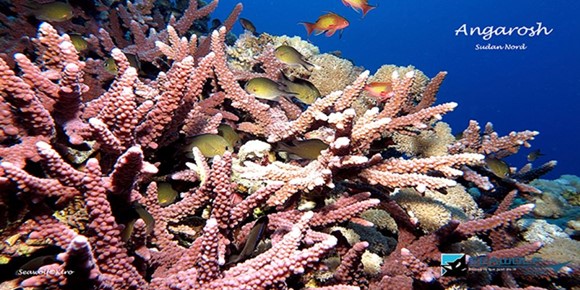Overview
The "Mother of Sharks", as Angarosh is translated in Arabic, is one of the most famous dive sites in Sudan. As the name says: encounters with the great hunters of the seas are the order of the day.
Description
The island, which rises only a few meters out of the water, has an elongated shape and lies 2.5 nautical miles south-southwest of Abington Reef.
The surrounding reef has a rather triangular shape and drops steeply into the depths on its outer sides.
There is a small plateau at the south end and a large plateau at the north end. Both places are known for possible encounters with different shark species. The number of animals depends on the season and water temperature.
Due to the exposed position, strong currents must be expected. This is also a reason why strikingly large schools of different pelagic fishes can be found.
North plateau with east side
At the north end facing north-east is the large plateau. At its base in 18 meters depth there is a large cave in the reef wall, which is bravely defended by two pairs of anemone fish.
The plateau descends evenly to 30 meters, continuing after a ledge at 40 meters.
Whip corals rise up and form almost small forests in some places. Often a swarm of barracudas circles here.
Especially at the tip of the plateau you have to expect strong currents. If the diver nevertheless manages to reach the edge, he can meet the sea creatures that have made this dive site so famous, especially in the morning hours.
Depending on the direction of the current, it is possible to dive on the east side of the reef. It would be a pity to just do the ascend of your dive here, because there is also a lot to discover on this section of the reef.
South of the northern plateau, at 10 meters, there are several caves where schools of glassfish seek shelter. One of the first caves can be reached at a depth of 4 meters through a small chimney leading downwards. Through the actual entrance you can dive out of the cave again.
Not far from the plateau approach, the diver comes across a larger coral block that is virtually overgrown with anemones. In the shallow water area, the entire colorful diversity of shapes and species that characterizes this area of water is displayed.
West wall with south plateau
In contrast to the east side, the west side is more strongly covered with crevices and overhangs.
Also striking are the accumulations of anemones, which attract the attention of the diver with their symbiotic clownfish.
Similar to the east side, the reef wall runs vertically up to 20 meters. Partly it is overhanging and in 40 meters it changes into a small sloping hillside. Cornetfish can be observed below the water surface.
Towards the south plateau, blue redtooth triggerfish stand out, swimming close to the reef wall in large numbers. Around the south end there is a narrow shallow water strip, but due to the swell it is too shallow for diving or snorkeling. It is populated with a variety of colorful reef life.
Below this section there are larger caves in the reef wall. The small plateau descends in two steps to a depth of 45 meters. On the first step there are some nice overgrown coral blocks at about 20 meters. At the level of the second one the area of the pelagic big fishes begins. Depending on the season there is a good chance to meet different species of sharks.
Hotspots
- Schools of scalloped hammerhead sharks approach curiously and also make the diver's heart beat faster. The whitetip reef sharks patrolling the plateau take more of a secondary position. Not seldom it happens that also mantas pass by. Calmly these giants are making their way over the plateau.

 ENGLISH
ENGLISH
 РУССКИЙ
РУССКИЙ
 DEUTSCH
DEUTSCH

